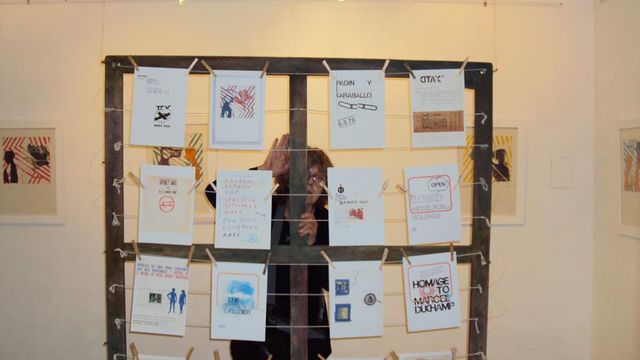
Graciela Gutiérrez Marx
The Argentine Graciela Gutiérrez Marx is one of the foremost Latin American exponents of mail art (a practice that involved sending small-scale art using the postal service). Born in La Plata in 1945, she graduated in 1967 with a degree in education and sculpture from the Escuela Superior de Bellas Artes, Universidad Nacional de La Plata. In the late 1960s Gutiérrez Marx exhibited her work at the Galería Lirolay in Buenos Aires and won several prizes for her rusted-metal sculptures. Through her friendship with Edgardo Antonio Vigo (1928–1997), with whom she would later work, she became interested in mail art. In 1975 Vigo and the artist Horacio Zabala (b. 1943) invited her to participate in Última exposición internacional de arte correo '75, the first mail-art exhibition in Argentina. For this exhibition Gutiérrez Marx presented woodcut envelopes with her face printed on them and rubber-stamp artworks whose tone anticipated the disappearance of thousands of people (including Vigo's son, Abel Luis Vigo) beginning in 1976 with the right-wing military coup.
From 1977 until 1983 Gutiérrez Marx and Vigo united as the artistic duo G. E. MarxVigo, and since then she has become one of the central voices among the international network of mail artists. Once democracy was restored in 1984, Marx worked collectively and individually under the signature GGMarx. During the exhibition Primer encuentro de arte experimental y mail-art, organized in 1984 in the city of Rosario, Gutiérrez Marx, Jorge Orta (b. 1953), Clemente Padín (b. 1939), Susana Lombardo (b. 1954), Mamablanca (Gutiérrez Marx's mother), Claudia del Río (b. 1957), and Noni Argañaraz (b. 1958) formed the Asociación Latinoamericana y del Caribe de Artistas-correo.
Since the 1980s Gutiérrez Marx has been involved in collaborative projects that she calls poemas colectivos (collective poems). One such example is El tendedero (The clothesline), presented at the Museo Municipal de La Plata in 1984, for which people were invited to build a collective poem by bringing a piece of clothing belonging to a loved one, writing a few words about the clothing on a notecard that was pinned to the item, and then sewing the pieces together to form a flag of collective memories. In the 1990s, encouraged by her son Martín Eckmeyer, she began painting. Gutiérrez Marx's drive to make art an essential component of daily life is a recurrent motif in her work. She continues to produce art and writes and lectures mainly on the topic of mail art. In 2007 she obtained a master's degree in aesthetics and art theory from the Universidad Nacional de La Plata.
—Marcela Guerrero
Selected Exhibitions
1968 Graciela Gutiérrez Marx, Galería Lirolay, Buenos Aires
1972 Arte platense—Panorama '72, La Cueva del 11, La Plata, Argentina
1985 Sombras de Hiroshima, International Shadow Project, La Plata, Argentina
2010 Fragmentos de archivo, Museo de Arte Contemporáneo Latinoamericano, La Plata, Argentina
2015 Resistance Performed: An Anthology on Aesthetic Strategies under Repressive Regimes in Latin America, Migros Museum für Gegenwartskunst, Zurich
Selected Bibliography
Gutiérrez Marx, Graciela. Artecorreo: Artistas invisibles en la red postal (1975–1995). Buenos Aires: Luna Verde, 2010.
———. Los códices marginales de mamablanca. Buenos Aires, 1980.
———. "Invisible Artists, or the Net without a Fisherman… (My Life in Mail Art)." Artmargins 1 (June–October 2012): 147–51.
Munder, Heike, ed. Resistance Performed: An Anthology on Aesthetic Strategies under Repressive Regimes in Latin America. Zurich: Migros Museum für Gegenwartskunst, 2015.
Padín, Clemente. Poesía visual latinoamericana. Barcelona: Quaderns i Edicions del Miau, 1999.


